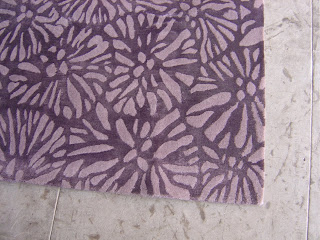Wool carpets are the easiest to clean because this natural animal fiber is non-absorbent, repels stains, and dries quickly. Wool is designed to keep sheep warm and dry in all weather. And Tibetan sheep, because they live at high altitudes, have the highest content of lanolin of any sheep. Lanolin keeps the wool softer, stronger, and more stain resistant.
The instructions in this guide are meant for fine handmade, hand dyed (vegetable or swiss dyes) wool carpets, not synthetic, or silk carpets.
Weekly carpet cleaning: vacuum once a week. Use a suction hose and head but not a stiff brush that rotates inside the head of the vacuum cleaner. Any stiff brush rotation will eventually tear up the carpet fibers and fringe.
Stains: Act fast and the wool fibers will keep the stain on the surface. Blot with a paper towel, then wipe or blot again with a wet cloth. Use more water and a bit of soap if the stain is heavier.
Pet Urine: Sponge or paper towel it away as quickly as possible, absorbing all the moisture you can. Add a tiny bit of vinegar to the water to lessen the smell. Next, this is a critical step, make sure you place dry towels or paper towels, under the carpet and on top of the carpet stain. Then place a heavy stack of books, magazines, or a full bucket of water on top of the paper towel/stain – anything heavy enough to absorb whatever urine or moisture might be left. Leave this towel/paper, carpet, towel/paper sandwich clean up for at least a few hours until the carpet is dry to the touch. Baking Soda sprinkled on the stain will also help absorb any odors. You can vacuum the baking soda away after a few hours also.
Discouraging Pets: I’ve been told by many customers that as soon as they place the carpet down in their homes, their pets roll around on the carpet and make it home. Pets like the smell of lanolin, after all it’s another animal smell they respond to. You can try spraying an air freshener on the carpet to mask the strong fresh lanolin smell they adore.
Red Wine: Blot as much red wine as you can off the carpet immediately, then pour dry salt on the remainder. Leave for a few minutes then vacuum the salt off. Repeat this several times. Finish by wiping the area with a dampened cotton towel. Some people recommend baking soda also to absorb the wine. If the stain remains, you may decide to have the carpet professionally cleaned, please no harsh chemicals or soaps, ask the carpet cleaner to use mild soap and water only.
Carpets will fade: No matter how good the dyes and dying process, all carpets will eventually fade in strong sunlight. Keep carpets protected from daily direct sunlight. Tinted windows, curtains, rolling carpets up – part of the day, throwing down sheets or towels over unprotected areas will all help prevent fading. NOTE: cheap synthetic dyes, especially the ones used in some silk Chinese rugs will fade badly in light or even run if washed.
Be aware of the two M’s: Moths, and Mildew
Moths will settle into an unprotected rug that is stored for long periods of time. They like darkness and quiet. Store the rug in moth balls, and check the rug every two/three months, move the rug, vacuum or shake it…disturbing any moth activity.
Mildew becomes established when a rug is left wet for long periods of time - weeks, months. Bad cases of mildew can definitely be seen and smelled. Wool will dry quickly if allowed to. The best way to eliminate mildew, is to have your carpet washed professionally…completely, and thoroughly cleaned. You too can try washing a smaller rug yourself on a warm summer day. Make sure the day is dry and warm above 80 degrees F. Use a garden hose, mild soap, and place the rug on stones, or a clean wooden pallet to dry…allowing air to circulate around the rug. Once dry look for any residual white spots, this may indicate that all the mildew has not been removed. Mildew will grow and spread if not eliminated. You may need to rewash the rug a couple of times…all depends upon the extent of the mildew.
Follow the washing instructions above for any general yearly cleaning of smaller area wool rugs. Larger rugs will need professionally cleaning from time to time depending upon pets, and traffic. Use a locally reputable carpet cleaner who comes to your home. Make sure, the company uses cold water and mild, mild soap and NO stiff brushes on the surface of your rugs. I hope these suggestions help…if you need more advice please contact us.
SHIVHON
(808)381-5102
http://www.shivhon.com/























